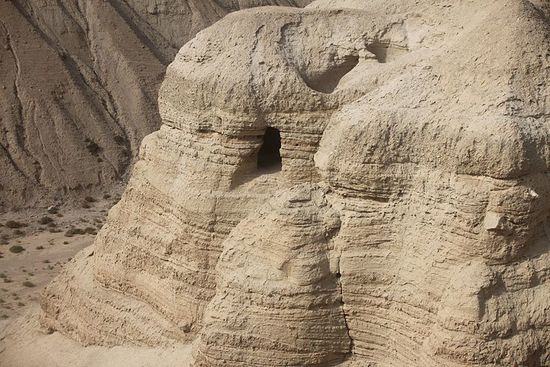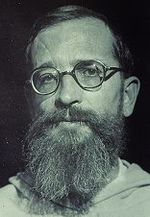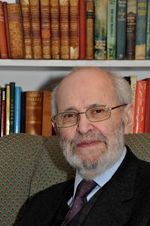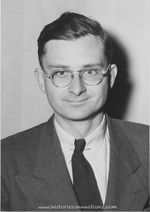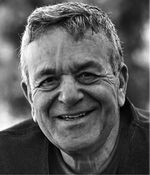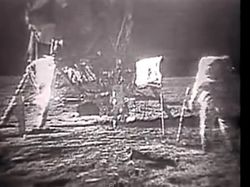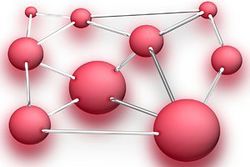Difference between revisions of "Category:Qumran Studies--1960s"
| Line 12: | Line 12: | ||
The page: '''Qumran Studies--1960s''', includes (in chronological order) fictional and literary works in the field of [[Qumran Studies]] made in the 1960s, or from 1960 and 1969. | The page: '''Qumran Studies--1960s''', includes (in chronological order) fictional and literary works in the field of [[Qumran Studies]] made in the 1960s, or from 1960 and 1969. | ||
[[File:Vaux.jpg|thumb|150px|[[Roland de Vaux]]]] | [[File:Vaux.jpg|thumb|150px|[[Roland de Vaux]]]] | ||
[[File:Geza Vermes.jpg|thumb|150px|[[Geza Vermes]]]] | [[File:Geza Vermes.jpg|thumb|150px|[[Geza Vermes]]]] | ||
[[File:John C. Trever.jpg|thumb|150px|[[John C. Trever]]]] | [[File:John C. Trever.jpg|thumb|150px|[[John C. Trever]]]] | ||
[[File:Magen Broshi.jpg|thumb|150px|[[Magen Broshi]]]] | [[File:Magen Broshi.jpg|thumb|150px|[[Magen Broshi]]]] | ||
}} | |||
{{WindowMain | {{WindowMain | ||
| Line 47: | Line 47: | ||
|content= | |content= | ||
}} | }} | ||
|} | |} | ||
| Line 105: | Line 98: | ||
|} | |} | ||
|} | |} | ||
== History of Research ([[1960s]]) -- Notes == | |||
[[File:Shrine Book Jerusalem.jpg|thumb|200px|The [[Shrine of the Book]] opened in 1965 at the Israel Museum, Jerusalem to host the collection of the Dead Sea Scrolls]] | |||
Four more volumes were published in the 1960s in the [[Discoveries in the Judaean Desert]] series: in 1961, 1962, 1965, and 1968, respectively. | |||
In 1961 most of the scrolls from Cave 11 were purchased by the Government of the Netherlands, and a center for Qumran research (the Groningen Qumran Institute) was established at the University of Groningen under the leadership of [[Adam S. van der Woude]]. | |||
In April 1965 the Scrolls from Cave 1 were permanently accommodated at the Israel Museum of Jerusalem in the [[Shrine of the Book]]; from 1965 to 1995 [[Magen Broshi]] would serve as curator of the collection. The international popularity of the Dead Sea Scrolls was enhanced by three major exhibitions, held at the National Museum of Natural History, Washington, DC (February 27 - March 21, 1965), at the University of Pennsylvania Museum, Philadelphia, PA (April 3-25, 1965), and at the British Museum London, England (December, 1965). | |||
When the 1967 Six-Day War broke out, the manuscripts at the [[Palestine Archaeological Museum]] fell into the hands of Israeli authorities with the exception of the [[Copper Scroll]] which was taken to the Jordan Archaeological Museum in Amman. During the war [[Yigael Yadin]] had also Kando's house searched to find the copy of the [[Temple Scroll]] Kando had kept 11 years hidden there under the floor. All the confiscated manuscripts were added to the collection of Dead Sea Scrolls at the [[Shrine of the Book]]. | |||
Revision as of 06:13, 21 November 2019
History of Research (1960s) -- Notes
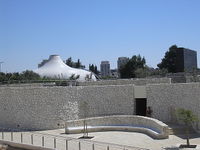
Four more volumes were published in the 1960s in the Discoveries in the Judaean Desert series: in 1961, 1962, 1965, and 1968, respectively.
In 1961 most of the scrolls from Cave 11 were purchased by the Government of the Netherlands, and a center for Qumran research (the Groningen Qumran Institute) was established at the University of Groningen under the leadership of Adam S. van der Woude.
In April 1965 the Scrolls from Cave 1 were permanently accommodated at the Israel Museum of Jerusalem in the Shrine of the Book; from 1965 to 1995 Magen Broshi would serve as curator of the collection. The international popularity of the Dead Sea Scrolls was enhanced by three major exhibitions, held at the National Museum of Natural History, Washington, DC (February 27 - March 21, 1965), at the University of Pennsylvania Museum, Philadelphia, PA (April 3-25, 1965), and at the British Museum London, England (December, 1965).
When the 1967 Six-Day War broke out, the manuscripts at the Palestine Archaeological Museum fell into the hands of Israeli authorities with the exception of the Copper Scroll which was taken to the Jordan Archaeological Museum in Amman. During the war Yigael Yadin had also Kando's house searched to find the copy of the Temple Scroll Kando had kept 11 years hidden there under the floor. All the confiscated manuscripts were added to the collection of Dead Sea Scrolls at the Shrine of the Book.
Pages in category "Qumran Studies--1960s"
The following 87 pages are in this category, out of 87 total.
1
- The Treasure of the Copper Scrolls (1960 Allegro), book
- Рукописи Мертового моря (The Dead Sea Scrolls / 1960 Amusin), book
- Offenbarung und Schriftforschung in der Qumransekte (1960 Betz), book
- Poklad v Judské poušti: Kumránské nálezy (Treasure in the Judean Desert: Qumran Findings / 1960 Bič), book
- Regula Belli seu Bellum Filiorum Lucis Contra Filios Obscuritas (1960 Boccaccio), book
- Biblical Exegesis in the Qumran Texts (1960 Bruce), book
- El Comentario de Habacuc de Qumrán (1960 Cantera Ortiz de Urbina), book
- Odkrycia w Qumran nad morzem martwym a Nowy Testament (The Discoveries at Qumran near the Dead Sea and the New Testament / 1960 Dabrowski), book
- Hodayot: Psalms from Qumran (1960 Holm-Nielsen), book
- Находки в Иудейской пустыне (Found in the Judean Desert / 1960 Kovalev, Kublanov), book
- Konkordanz zu den Qumrantexten (Concordance to the Qumran Texts / 1960 Kuhn), book
- Les interpolations chrétiennes des Testaments des Douze Patriarches et les manuscrits de Qoumrân (1960 Philonenko), book
- Bijbelverklaring te Qumrân (1960 Ploeg), book
- Los manuscritos del Mar Muerto (Dead Sea Scrolls / 1960 Scazzocchio Sestieri), book
- The Monks of Qumran as Depicted in the Dead Sea Scrolls (1960 Sutcliffe), book
- Рукописи Мертвого Моря (Dead Sea Scrolls / 1960 Varshavskiĭ), book
- Les grottes de Murabba'ât (The Murabba'at Caves / DJD 2 / 1961 Benoit, Milik, Vaux), book
- A holt-tengeri tekercsek (1961 Burrows / József, Komoróczy) = The Dead Sea Scrolls (1955 Burrows), book (Hungarian ed.)
- 死海写本 = Dead Sea Scrolls (1961 Burrows / Shinmi, Kanō), book (Japanese ed.)
- Wykopaliska w Qumran a pochodzenie chrzescijanstwa (The Excavations at Qumran and the Origins of Christianity / 1961 Chylinski), book
- The Ancient Library of Qumran and Modern Biblical Studies, 2nd ed. (1961 Cross), book
- (+) The Essene Writings from Qumran = Les écrits esséniens découverts près de la mer Morte (1961 Dupont-Sommer / Vermès), book (English ed.)
- Qumran (1961 Grözinger), book
- The Dead Sea Scrolls: An Introduction (1961 Harrison), book
- Les manuscrits de la Mer Morte (The Dead Sea Scrolls / 1961 Laperrousaz), book
- From Judaean Caves: The Story of the Dead Sea Scrolls (1961 Leaney), book
- The Thanksgiving Hymns (1961 Mansoor), book
- Tro och liv enligt Döda-havsrullarna (The Faith of Qumran: Theology of the Dead Sea Scrolls / 1961 Ringgren), book
- La comunidad del Mar Muerto = Die Gemeinde vom Toten Meer (1961 @1958 Schubert / Lang), book (Spanish ed.)
- Die Höhle am Toten Meer (1961 Stoll), non-fiction
- Kultzeiten und kultischer Bundesschluss in der "Ordensregal" vom Toten Meer (1961 Weise), book
- Les "petites grottes" de Qumran (The Small Caves of Qumran / DJD 3 / 1962 Baillet, Milik, Vaux), book
- Christ and the Teacher of Righteousness = Le Docteur de Justice et Jésus-Christ (1962 @1957 Carmignac / Pedley), book (English ed.)
- 死海写本 = Les manuscrits de la Mer Morte (The Dead Sea Scrolls / 1962 Laperrousaz / Nozawa), book (Japanese ed.)
- (+) The Dead Sea Scrolls and the Early Church (1962 Mowry), book
- Manuscrisele de la Marea Moarta (1963 Amusin), book (Romanian ed.)
- Rekopisy znad Morza Martwego = Рукописи Мертового моря (Dead Sea Scrolls / 1963 @1960 Amusin / Kunderewicz), book (Polish ed.)
- Der Paraklet (1963 Betz), book
- 死海文書 : テキストの翻訳と解說 = More Light on the Dead Sea Scrolls (1963 Burrows), book (Japanese ed.)
- Ce que l'Ancien Testament ne dit pas (The Old Testament Apocrypha / 1963 Dimier), book
- Der Lehrer der Gerechtigkeit (The Teacher of Righteousness / 1963 Jeremias), book
- The Faith of Qumran: Theology of the Dead Sea Scrolls = Tro och liv enligt Döda-havsrullarna (1963 @1961 Ringgren / Sander), book (English ed.)
- From Moses to Qumran: Studies in the Old Testament (1963 Rowley), book
- Rekopisy z Qumran nad Morzem Martwym (Dead Sea Scrolls / 1963 Tyloch), book
- Odkrycia nad Morzem Martwym = The Scrolls from the Dead Sea (1963 @1955 Wilson / Swiecka), non-fiction (Polish ed.)
- Находки с Мертвого моря (Dead Sea Discoveries / 1964 Amusin), book
- Das Heil Gottes: Heils- und Sündenbegriffe in den Qumrantexten und im Neuen Testament (1964 Becker), book
- Lo que no dice el Antiguo Testamento = Ce que l'Ancien Testament ne dit pas (The Old Testament Apocrypha / 1964 Dimier / Revilla), book (Spanish ed.)
- Quello che l'Antico Testamento non dice = Ce que l'Ancien Testament ne dit pas (The Old Testament Apocrypha / 1964 Dimier / Martinetto), book (Italian ed.)
- The Old Testament Apocrypha = Ce que l'Ancien Testament ne dit pas (1964 Dimier / Tester), book (English ed.)
- Einleitung in das Alte Testament unter Einschluss der Apokryphen und Pseudepigraphen, 3rd ed. (1964 Eissfeldt), book
- Los manuscritos del mar Muerto (1964 Laperrousaz / Abril) = Les manuscrits de la Mer Morte (The Dead Sea Scrolls / 1961 Laperrousaz), book (Argentine ed.)
- (+) The Dead Sea Scrolls: A College Textbook and A Study Guide (1964 Mansoor), book
- Jesus and the Wilderness Community at Qumran = Jesus und die Wüstengemeinde am Toten Meer (1964 @1957 Stauffer / Spaltholz), book (English ed.)
- Rättfärdighetens lärare = The Teacher of Righteousness (1964 Wallendorff), book
- Was nicht im Alten Testament steht = Ce que l'Ancien Testament ne dit pas (The Old Testament Apocrypha / 1965 Dimier / Lampus), book (German ed.)
- The Judaean Scrolls: The Problem and a Solution (1965 Driver), book
- (++) The Old Testament: An Introduction, Including the Apocrypha and Pseudepigrapha = Einleitung in das Alte Testament unter Einschluss der Apokryphen und Pseudepigraphen, 3rd ed. (1965 @1964 Eissfeldt / Ackroyd), book (English ed.)
- The Temple and the Community in Qumran and the New Testament (1965 Gärtner), book
- Himnos de los neófitos de Qumrán (1965-1975 Rodrigo), music
- The Psalms Scroll of Qumran Cave 11 (DJD 4 / 1965 Sanders), book
- (+) The Untold Story of Qumran (1965 Trever), book
- A Comparative Study of the Old Testament Text in the Dead Sea Scrolls and in the New Testament (1965 Waard), book
- Skriftrullerne fra Det døde Hav = The Dead Sea Scrolls (1966 Allegro / Haderslev), book (Danish ed.)
- 死海写本とキリスト敎の起源 = The Dead Sea Scrolls and Christian Origins (1966 Black / Shinmi), book (Japanese ed.)
- A Long Way to Shiloh / The Menorah Men (1966 Davidson), novel
- Enderwartung und gegenwärtiges Heil: Untersuchungen zu den Gemeindeliedern von Qumran mit einem Anhang über Eschatologie und Gegenwart in der Verkündigung Jesu (1966 Kuhn), book
- (+) The Rule of Qumran and Its Meaning (1966 Leaney), book
- Die antike Bibliothek von Qumran und die moderne biblische Wissenschaft (1967 Cross), book (German ed.)
- Les thèmes de connaissance dans le document de Damas (1967 Denis), book
- Происхождение христианства в свете свитки Мертвого моря (The Origin of Christianity in Light of the Dead Sea Scrolls / 1967 Livshits), book
- I manoscritti del Mar Morto (1967 Michelini Tocci), book
- Pseudépigraphes de l'Ancien Testament et manuscrits de la Mer Morte (1967 Philonenko), book
- Η περί Μεσσίου πίστις των ερημιτών του Khirbet Qumran (1967 Rigopoulos), book
- (+) The Dead Sea Psalms Scroll (1967 Sanders), book
- A holt-tengeri barlangok rejtélye = Die Höhle am Toten Meer (1967 Stoll / Nyilas), non-fiction (Hungarian ed.)
- مخطوطات البحر الميت (Dead Sea Scrolls / 1967 ʻĀbidī), book
- Qumrân Cave 4.I (DJD 5 / 1968 Allegro, Anderson), book
- Die Doppelurkunden aus der Wüste Juda (1968 Koffmahn), book
- Dziesiec lat odkryc na pustyni judzkiej = Dix ans de découvertes dans le Désert de Juda (Ten Years of Discoveries in the Wilderness of Judaea / 1968 @1957 Milik / Kubiak), book (Polish ed.)
- Rukopisy od Mrtvého moře = The Dead Sea Scrolls (1969 Allegro / Mareš, Žilina), book (Czech ed.)
- 死海卷與基督敎信仰 = The Dead Sea Scrolls and the Christian Faith (1969 LaSor / Shen), book (Chinese ed)
- Gott und Belial: Traditionsgeschichtliche Untersuchungen zum Dualismus in den Texten aus Qumran (1969 Osten-Sacken), book
- (+) The Dead Sea Scrolls and the Bible (1969 Pfeiffer), book
- Τά χειρόγραφα τῆς Νεκρᾶς Θαλάσσης (1969 Siotis), book
Media in category "Qumran Studies--1960s"
The following 9 files are in this category, out of 9 total.
- 1961 * Black.jpg 232 × 350; 28 KB
- 1961 * Vaux.jpg 317 × 499; 19 KB
- 1962 * Vermes.jpg 321 × 499; 37 KB
- 1964 * Brownlee.jpg 334 × 499; 37 KB
- 1964 * Gaster.png 856 × 1,416; 2.46 MB
- 1966 Braun.png 357 × 536; 29 KB
- 1968 Murphy-O'Connor.jpg 284 × 363; 18 KB
- 1969-E Black.jpg 360 × 568; 48 KB
- 1969 * Wilson.jpg 299 × 499; 28 KB
